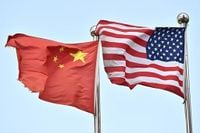On October 20, 2025, China’s Ministry of State Security (MSS) unleashed a volley of accusations against the United States, charging the U.S. National Security Agency (NSA) with orchestrating a series of cyberattacks targeting one of China’s most crucial pieces of digital infrastructure: the National Time Service Center (NTSC). The center, responsible for generating and distributing China’s official standard time, plays a pivotal role in keeping the nation’s communications, finance, power, transport, and defense sectors running in perfect synchrony. The gravity of the allegations has reverberated far beyond Beijing and Washington, reigniting debate over the shadowy world of state-sponsored cyberwarfare and the fragile trust underpinning the global digital order.
According to the MSS, the NSA’s campaign began in early 2022. Chinese investigators allege that the American spy agency exploited vulnerabilities in the messaging services of a foreign-brand mobile phone—though the brand remains unnamed—to steal sensitive data from NTSC staff devices. In a series of posts on the social media platform WeChat and statements to state broadcasters, the MSS painted a picture of escalating digital aggression: the NSA, they claim, deployed 42 different types of “special cyberattack weapons” to infiltrate and disrupt the NTSC’s internal network systems between 2023 and 2024. The ultimate goal, Chinese officials say, was to compromise a key timing system that underpins everything from the country’s electricity grid to its satellite navigation.
“The U.S. is accusing others of what it does itself, repeatedly hyping up claims about Chinese cyber threats,” the MSS stated in its public post, as reported by Associated Press and SecurityWeek. The ministry further alleged that the NSA’s actions could have led to catastrophic consequences, disrupting network communications, financial systems, power supply, and even national defense capabilities. Wei Dong, a senior official at the NTSC, told state broadcaster CCTV, “The alleged hack could endanger crucial timing systems, cause failures at power substations and throw out satellite navigation systems.”
Despite the seriousness of the claims, the MSS did not publicly provide forensic evidence to back up its assertions. Instead, the agency said it had given the NTSC guidance on how to eliminate the risks and shore up its digital defenses. The lack of concrete proof has not stopped the story from dominating headlines and fueling already simmering tensions between the world’s two largest economies.
The U.S. response was measured, if not downright evasive. When asked for comment, the NSA told Newsweek and Nextgov/FCW, “NSA does not confirm nor deny allegations in the media regarding its operations. Our core focus is countering foreign malign activities persistently targeting American interests, and we will continue to defend against adversaries wishing to threaten us.” The U.S. Embassy in Beijing, for its part, sidestepped the specific allegations and instead countered with its own charge sheet, asserting that China “is the most active and persistent cyber threat to U.S. government, private-sector and critical infrastructure networks.”
This digital tit-for-tat is nothing new. As PC Gamer and SecurityWeek point out, accusations of cyberespionage and sabotage have become a regular feature of U.S.-China relations. In recent years, Washington has blamed Chinese state-backed hackers for attacks on Western officials, journalists, corporations, and even government agencies. Notable incidents include the 2024 telecoms breach—described as the “worst in the nation’s history” by U.S. officials—and the infiltration of the U.S. Treasury and Nuclear Security Administration, both attributed to Chinese actors. Meanwhile, Beijing has repeatedly accused the U.S. of deploying its own “cyber-infiltration techniques” against Chinese networks, referencing the infamous revelations from former NSA contractor Edward Snowden and more recent claims of attacks on Chinese sporting event infrastructure.
What makes the current episode stand out is the target: time itself. The NTSC, affiliated with the Chinese Academy of Sciences, is not just a scientific curiosity; it is the beating heart of the nation’s digital infrastructure. “This type of cyberattack is considered a classic form of state-level cyber aggression, internationally referred to as an advanced persistent threat,” Li Jianhua, director of the National Engineering Laboratory for Information Content Analysis Technology at Shanghai Jiao Tong University, told CCTV. “Its objectives include infiltrating, monitoring, disrupting or even destroying key infrastructure in other countries – posing a severe threat to any nation.”
Experts note that compromising a country’s time service could have cascading effects. From financial transactions and power grid synchronization to military communications and transportation logistics, everything runs on precise timing. A successful attack could, in theory, disrupt the very fabric of modern life. “The headquarters of Chinese time would certainly make for a disruptive target,” mused PC Gamer, “but won’t someone think of whoever has to adjust the clocks?”
The timing of China’s accusations has also raised eyebrows. They arrived just as a major Amazon Web Services (AWS) outage sent shockwaves across the globe, knocking out some of the world’s biggest websites and apps. While there is no evidence linking the AWS incident to the alleged NSA attacks, the convergence of events has only heightened anxieties about the vulnerability of critical infrastructure in an age of digital interdependence. Add in renewed U.S.-China trade tensions—sparked by Beijing’s tightening of rare earth export controls and threats of new American tariffs—and the stage is set for a broader confrontation that transcends cyberspace.
Despite the flurry of accusations, neither side appears eager to escalate the dispute into open cyberwarfare. Instead, both Washington and Beijing seem content to play a high-stakes game of digital brinksmanship, each accusing the other of hypocrisy while refusing to offer full transparency. The MSS’s assertion that the U.S. “repeatedly hyped up claims about Chinese cyber threats” mirrors Washington’s own rhetoric about Beijing’s cyber activities. The result is a kind of mutually assured suspicion, with each side convinced that the other is the true aggressor.
For now, the world is left watching as two of the most powerful nations on earth spar over the invisible lines of cyberspace. The stakes could hardly be higher: not just for the integrity of China’s timekeeping, but for the delicate balance of trust and power that sustains the global digital ecosystem. As the dust settles, it’s clear that the battle for control over information—and the infrastructure that keeps our world ticking—shows no sign of letting up.
With both sides digging in and the evidence yet to be made public, the world’s clocks keep ticking, but the question of who holds the keys to the digital kingdom remains as unsettled as ever.






